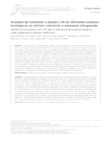Please use this identifier to cite or link to this item:
http://www.alice.cnptia.embrapa.br/alice/handle/doc/1062667| Title: | Acúmulo de nutrientes e relação C/N em diferentes estádios fenológicos do milheto submetido à adubação nitrogenada. |
| Authors: | FOLONI, J. S. S.  CATUCHI, T. A.   BARBOSA, A. de M.   CALONEGO, J. C.   TIRITAN, C. S.   |
| Affiliation: | JOSE SALVADOR SIMONETI FOLONI, CNPSO; TIAGO ARANDA CATUCHI, UNOESTE; ALEXANDRIUS DE MORAES BARBOSA, UNOESTE; JULIANO CARLOS CALONEGO, UNESP; CARLOS SÉRGIO TIRITAN, UNOESTE. |
| Date Issued: | 2016 |
| Citation: | Revista Agro@mbiente On-line, Boa Vista, v. 10, n. 1, p. 1-9, 2016. |
| Description: | RESUMO: A produtividade e a qualidade da matéria seca produzida pelo milheto dependem da época de corte da forrageira e da adubação nitrogenada. Dessa forma, objetivou-se avaliar a produção de matéria seca (MS), o teor e acúmulo de nutrientes e a relação C/N em diferentes estádios fenológicos do milheto em função dos níveis de adubação nitrogenada. O experimento foi conduzido em casa de vegetação na Universidade do Oeste Paulista, em Presidente Prudente-SP, em delineamento inteiramente causalizado, em esquema fatorial 4x4, com quatro repetições. Os fatores consistiram de quatro doses de nitrogênio (0, 50, 100 e 200 kg ha-1 de N) e quatro épocas de corte da parte aérea, assim discriminadas: folha bandeira; emborrachamento; florescimento e grão leitoso. O maior acúmulo de massa seca das plantas de milheto ocorreu nos estádios de florescimento e de grão leitoso, considerando que a produção foi incrementada com a adubação nitrogenada. Objetivando-se a persistência de palhada no solo para a cultura sucessora, recomenda-se o corte das plantas nos estádios de florescimento e grão leitoso, quando há maior relação C/N. A adubação nitrogenada aumenta o teor e o acúmulo de nutrientes na palhada, como, também, aumenta a liberação de nutrientes para a cultura sucessora devido a menor relação C/N da palhada. ABSTRACT: The productivity and quality of dry matter produced by millet depend on when the forage is cut, and the use of nitrogen fertilisation. Accordingly, the aim of this study was to evaluate the production of dry matter (DM), the levels and accumulation of nutrients, and the C to N ratio at different phenological growth stages of the millet for levels of nitrogen fertilisation. The experiment was carried out in a greenhouse at the University of West São Paulo, in Presidente Prudente, in the State of São Paulo, Brazil. The design was completely randomised, in 4 x 4 factorial scheme with four replications. The factors consisted of four rates of nitrogen (0, 50, 100 and 200 kg N ha-1) and four periods for cutting the shoots, as follows: flag leaf, boot, flowering and milk stage. The greatest accumulation of dry matter in the millet occurred at the flowering and milk stages, considering that production was increased with nitrogen fertilisation. With the aim of maintaining straw on the ground for the succeeding crop, cutting is recommended at the flowering and milk stages, when there is a higher C to N ratio. Nitrogen fertilisation increases the levels and accumulation of nutrients in the straw, as well as increasing the release of nutrients to the succeeding crop, due to a lower C to N ratio in the straw. |
| Thesagro: | Plantio direto Nutrição Milheto |
| NAL Thesaurus: | Millets Nitrogen fertilizers |
| Keywords: | Adubacao nitrogenada |
| ISSN: | 1982-8470 |
| DOI: | 10.18227/1982-8470ragro.v10i1.2798 |
| Type of Material: | Artigo de periódico |
| Access: | openAccess |
| Appears in Collections: | Artigo em periódico indexado (CNPSO)  |
Files in This Item:
| File | Description | Size | Format | |
|---|---|---|---|---|
| 2798141851PB.pdf | 1,35 MB | Adobe PDF |  View/Open |









